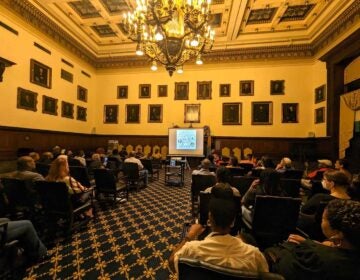Rehab of public housing project seeks to bridge divide between Temple University and North Philadelphia
Norris — which has housed generations of low-income Philadelphians — is undergoing a redevelopment.
Listen 5:38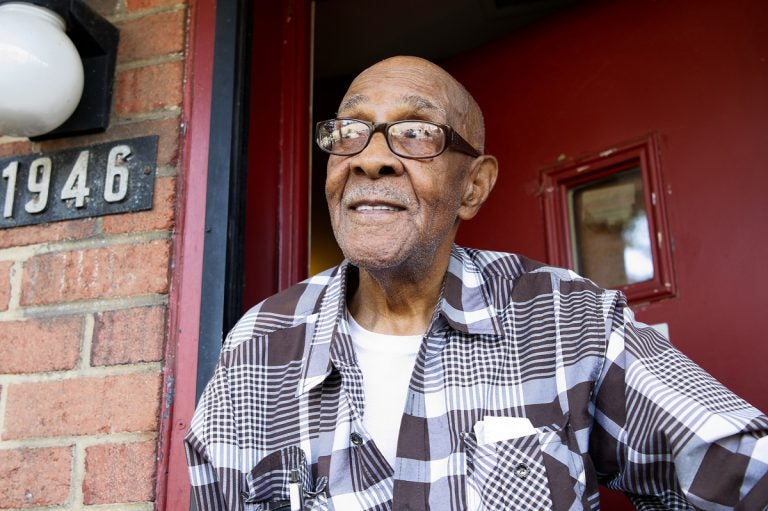
Albert Hill, 87, has lived at the Norris Homes for more than 50 years. He's looking forward to returning to the homes once the development is complete. (Bastiaan Slabbers/for WHYY)
In the shadow of a stack of Temple University high-rise buildings, the late-autumn leaves carpeted the damp ground at the Norris Homes in North Philadelphia, a reminder that hardly anyone lives in the public housing project anymore.
It was early November and most of the 147 townhomes in the Norris housing project were boarded up. Soon, everyone would be gone, and artist Jennie Shanker came to take another look.
“There’s a really important community that was at Norris. And it’s not just the people who are living there now,” said Shanker, a professor in Temple’s Tyler School of Art. “There were people who were part of Norris community who were there when it was first opened in 1952. There are reunions every year. Five-hundred people show up.”
Local leaders, though, are hoping this is less a story of displacement, than one of rebirth.
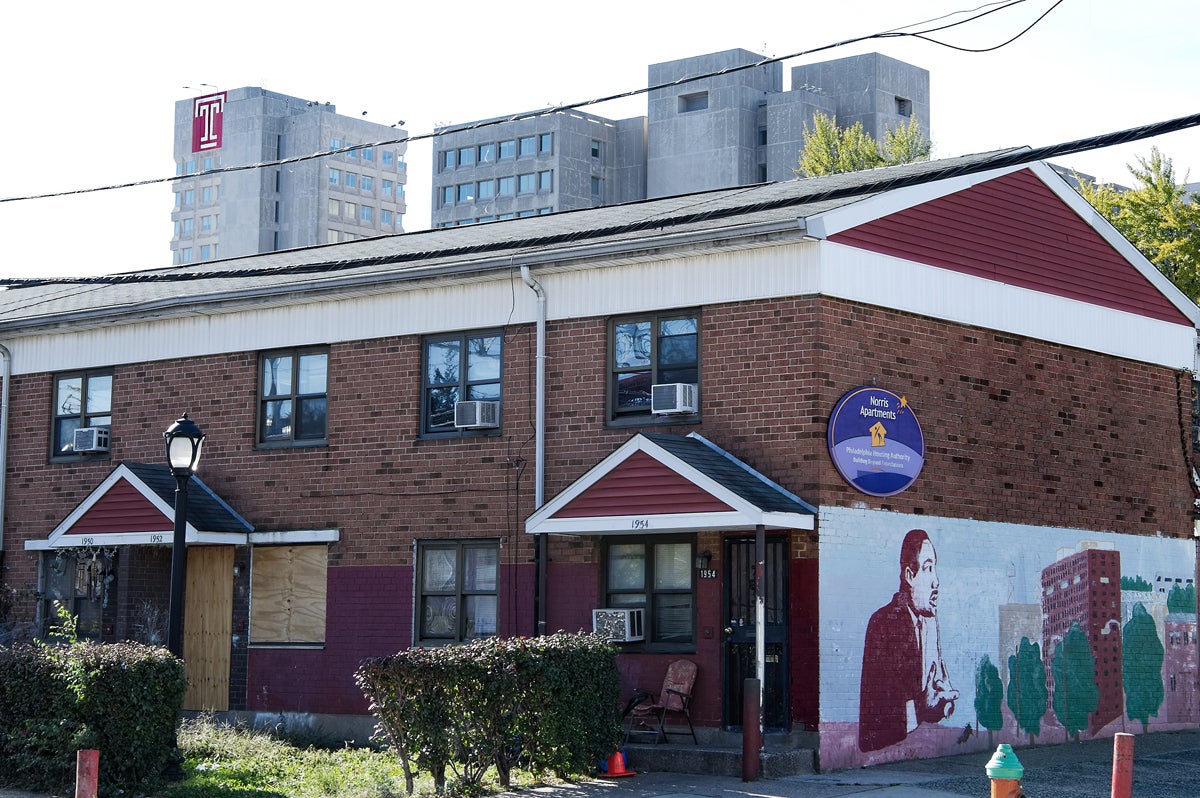
Norris — which has housed generations of low-income Philadelphians — is undergoing a redevelopment believed to have the potential to help bridge the divide between one of the poorest, most distressed sections of the city and the fast-growing university in its midst.
The new development will feature commercial space, as well as 300 residential units rented at both market and subsidized rates. It’s been purposefully planned to incorporate low-income families into the area’s social blueprint, while further beautifying the vibrant educational hub that is Temple.
“We didn’t want the kind of super block of isolated poverty concentrated development anymore. It doesn’t work,” said Kelvin Jeremiah, Philadelphia Housing Authority’s president and CEO. “ We want our residents to be part of the change that is happening.”

Elephant in the room
When a college or university thrives, it can be the life-blood of its surrounding community — bringing resources, attention and general economic benefits. But these institutions can also spur changes that can displace or marginalize their immediate neighbors, especially low-income ones.
Donna Richardson, president of the Norris Community Resident Council, has lived at Norris for 28 years and has watched closely the tensions that have flared as Temple’s footprint has expanded, with its student population nearly doubling over the past two decades.
“A lot of times, the kids you hear their conversation, and they’re looking at us like we’re poor people or we’re nobody,” Richardson said.
The housing project is wedged between Temple’s main campus and a commuter stop used by students on one of SEPTA’s regional rail lines. Residents have complained that they feel dismissed as a community, with commuters littering outside of their homes and taking their parking spots.
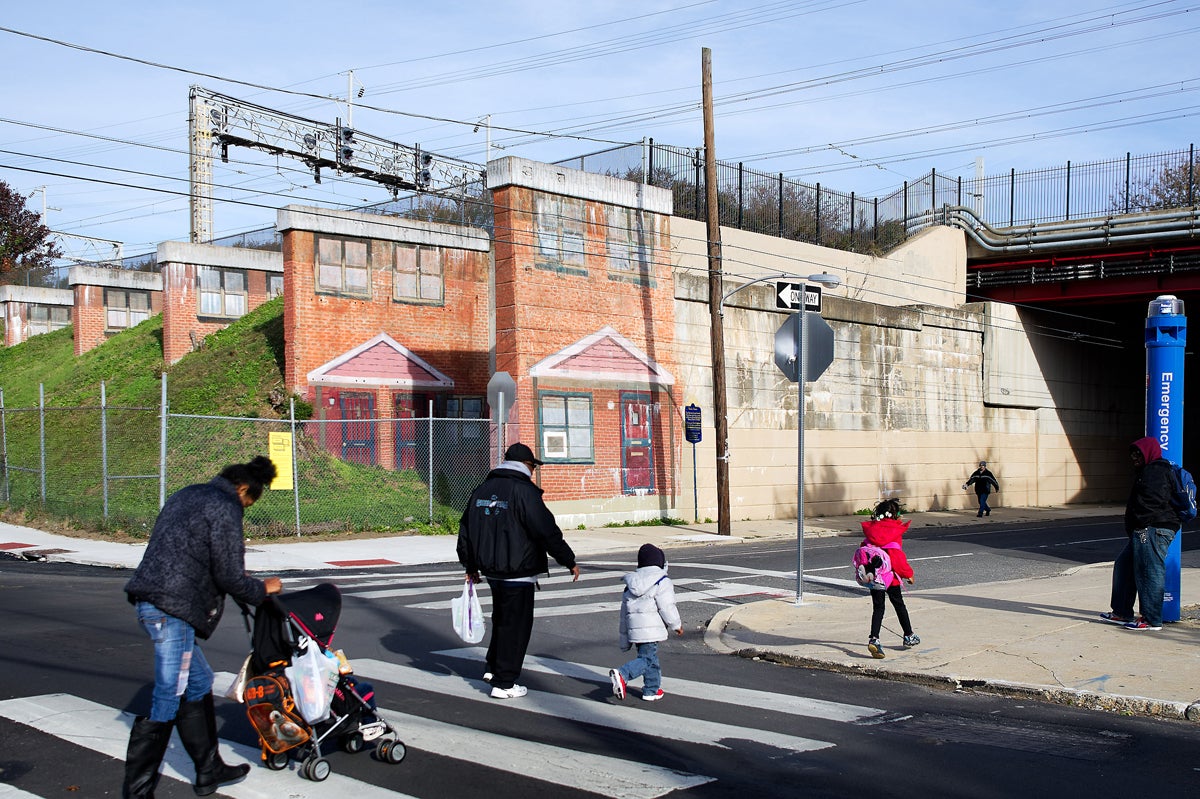
“College students are a mess,” she said. “They have no respect. They tramp over you.”
When it comes to Norris, which is owned by PHA, Temple has long been the elephant in the room. For years, residents feared that PHA would sell the housing project to Temple or other developers who have shown interest.
Jeremiah said he had to put a stop to rumors swirling about Norris.
“We went to Temple and said our residents aren’t going anywhere. We aren’t selling Norris,” Jeremiah said. “We will develop it. And we went to Temple and said we want you to be part of this.”
This eventually led to the current rehabilitation. The $125 million project is being financed with a $30 million grant approved in 2014 from the U.S. Department of Housing and Urban Development, as well as city tax credits and private funds.
Temple also kicked in $1 million, said Beverly Coleman, the university’s assistant vice president for community relations. Thirty homes will be available for sale, and 12 Norris residents have already expressed interest, Richardson said.
The new Norris will replace the worn, low-lying townhomes with handsome brick-and-siding facades of two and three-story units, complete with modern kitchens, central air conditioning and washers and dryers.
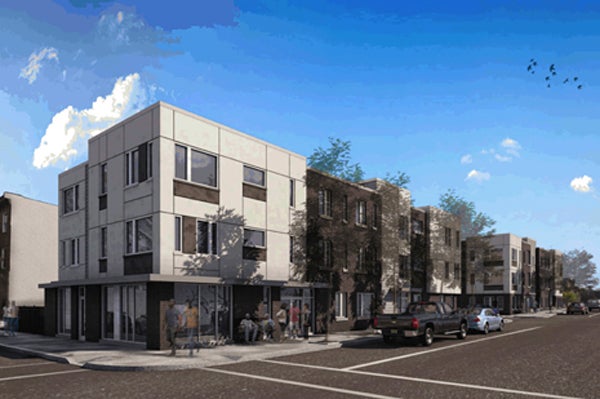
Public housing residents pay no more than 30 percent of their incomes for rent, while PHA covers the rest. In Philadelphia, on average, renters pay $300 a month.
“The fact we’re doing this without diminishing affordability in the area, the fact that we’re doing it by increasing the number of affordable rental units there is incredible,” Jeremiah said.
‘I’m just used to this place’
But even this seemingly positive change has been tough on some long-term residents.They’re guaranteed a spot in the new development, but they’ve needed to relocate temporarily until the rehab completes. And even though PHA pays for moving expenses, it’s a hassle, especially for seniors.
Albert Hill, 87, has lived in the Norris Homes for 57 years.
“All my kids raised up in here — my grandkids, my great-grands … I’m just used to this place,” he said.
In Hill’s townhouse, signs that a move is eminent are all around. Boxes full of papers clutter his living room. He’s been told he’ll be located to another public housing development a mile away, but he’s worried about being farther from his doctor’s office while he’s in his temporary space. So he definitely plans to come back to Norris.
“I would have to ride the bus…,” Hill ponders aloud, trying to remember the route. “One of those streets up there or something? I’m not sure.”
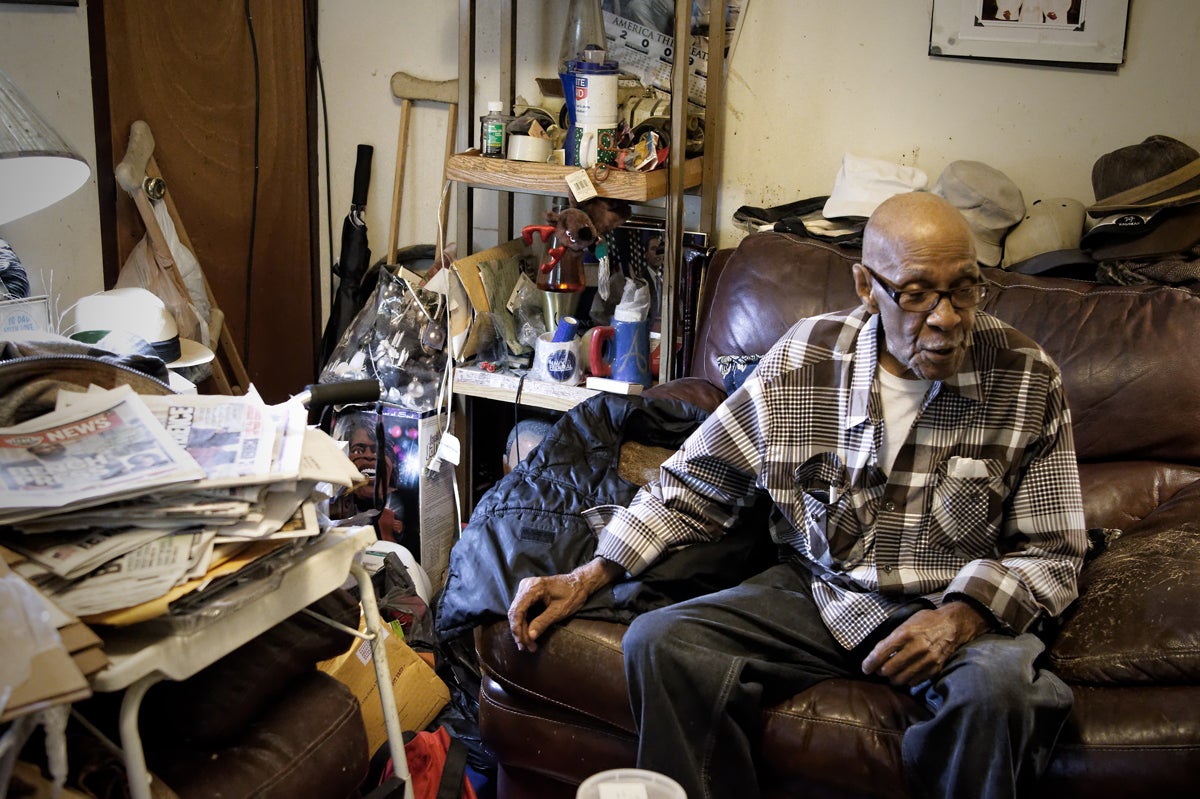
The moving process was too much for long-time Norris resident Joanne Simmons.
Simmons lived in Norris for 30 years, raised her two daughters there. She has been relocated already to another nearby housing project. It’s a high rise for seniors, which she says is more peaceful. There, she doesn’t have to worry about things like neighborhood teenagers lingering in front of her house at night.
“I don’t have to keep cutting my light on and off when they up there on my step,” she said. “Because you can’t open the door and tell them, because you don’t know what they have in their pocket.”
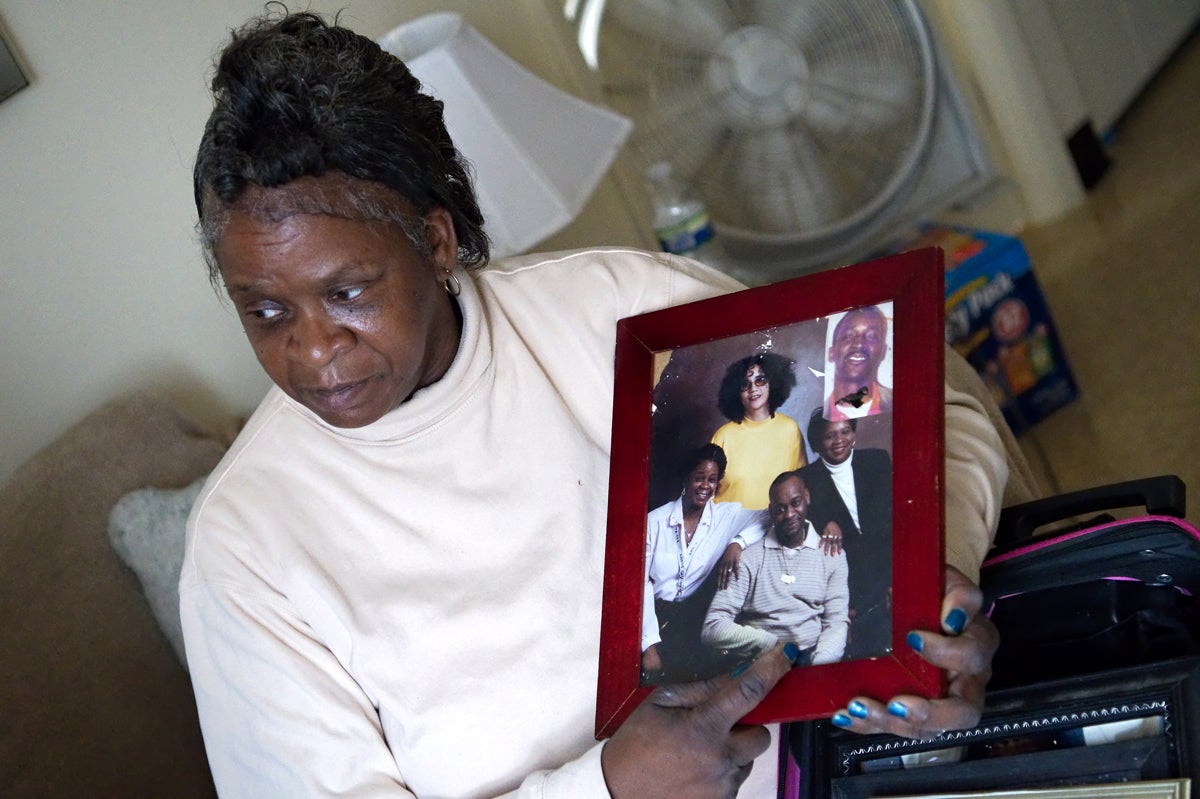
But despite the inconvenience, all of the residents interviewed by Keystone Crossroads say they are glad to see Norris get a badly needed overhaul.
“I think it’s a godsend,” said Richardson.
Richardson says the new development will bring a level of dignity back to the community that the worn down older units couldn’t convey. She’s especially happy that, as part of the collaborative agreement, Temple has increased its community outreach efforts. It’s developed an after school program and a summer camp for kids, as well as adult courses in G.E.D.-prep, financial literacy and job readiness.
The university began to implement the programs in 2014 under the leadership of Temple Urban Education Professor James Earl Davis.
“As a university we have to continue to learn how to be good neighbors, and engage our neighbors in a way that is respectful and a listening kind of way,” Davis said. “That’s been hard and difficult historically. We can do better and we are.”
Richardson agrees, saying the work being done at Norris is changing the way the community sees the university.
“The residents have gained so much,” she said.“They have opened up training that was free, not just training when you get a certificate that hangs on the wall, but training that leads to employment. They can start at $15 and up and also with insurance and benefits…That’s a blessing.”
The university also sees the grant as a win-win.
“Our relationship with Norris is more robust and probably more proactive since the implementation of the grant,” said Coleman. “The fact that the redevelopment will be more attractive and modern benefits both the community and Temple University.”
But what seems to get lost in anticipating a better future for Norris is its past, which Shanker, the artist, says is worth preserving.
Shanker has spent three years helping the residents tell their stories before the old Norris fades into the dust of demolition.

Her exhibition, “The Mighty Mighty Norris,” is shown at a nearby art studio.
“People move through projects. They go on with their lives. They become professionals. Some of them become famous. So many people come back, and it means so much to people to be from Norris,” Shanker said. “ Once Norris is gone, there’s a huge loss there.”
The first of the new Norris homes will be ready by April 2018. The rehab is expected to be fully complete by September 2018.
This story is part of an occasional Keystone Crossroads’ series examining the impact of colleges and universities on communities in Pennsylvania. The series was made possible with support from the Knight Foundation.
WHYY is your source for fact-based, in-depth journalism and information. As a nonprofit organization, we rely on financial support from readers like you. Please give today.






